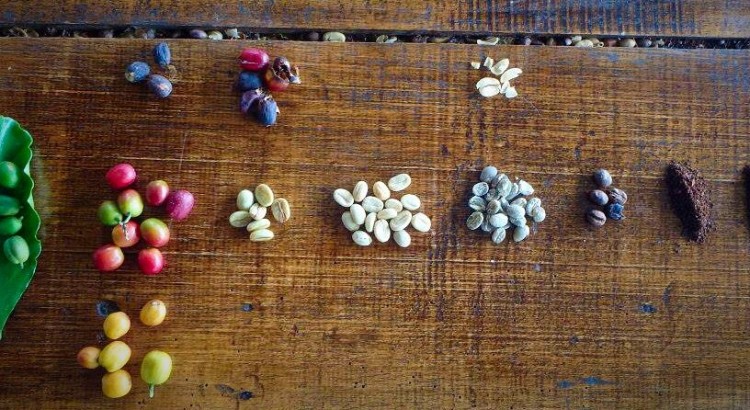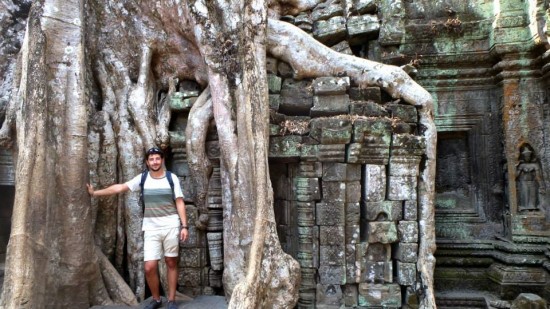We didn’t think it right to visit Colombia’s Coffee Triangle without taking a little time to learn about the brown stuff and how it’s produced. In between relaxing in the tiny colonial town of Salento and visiting the magnificent Cocora Valley, we decided to head on a tour of a coffee plantation.
Plantation House Coffee Tour
There are literally dozens of coffee tour providers in Salento, which range from a casual chat and a stroll around a plantation to a much more thorough lesson on the coffee production process and the politics and economics surrounding it. Plantation House offer the latter.
The tour takes place on Finca Don Eduardo, the plantation owned by the same folks which own Plantation House Hostel (it‘s a pretty basic hostel, but very relaxed and amidst some great scenery).
Growing the Beans
Most farms now grow modern coffee, which has been modified through selective breeding (not GM) to make the coffee easier to grow and to harvest. But many farmers are choosing to stick with traditional coffee because it‘s, you know, traditional.
A little known fact about Colombian coffee is that it is graded on size, not quality. This is for two reasons, first, because it’s regarded that larger beans are larger and therefore better. Makes sense, I suppose. The second reason is that different varieties of Arabica beans, all of which offer degrees of quality, all fetch exactly the same price as the industry is accustomed to throwing them all in together.
Don Eduardo (British born Timothy Harbour) likes to keep his beans separate to filter out the lower quality beans, much to the dismay of the workers.
 Hostel owner
Hostel owner John Hammond Don Eduardo walks us to the plantaion.
 Banana trees surround the coffee plants to offer shade
Banana trees surround the coffee plants to offer shade
Washing the Beans
Once harvested, the raw coffee fruit (referred to as coffee cherries) need to be peeled and dried. Before drying, though, there is a process known as washing. Some farms do not wash their beans during production, but this produces a lower quality batch. You didn’t know there was this much to producing coffee, did you?
 Removing the outer skin of the cherries.
Removing the outer skin of the cherries.
The skinned cherries sit in water for a couple of days which allows a further layer of skin to ferment away, leaving the beans ready for drying.
Drying the Beans
 Beans left to dry in a poly-tunnel.
Beans left to dry in a poly-tunnel.
 Once dried, a final skin can be removed by hand or by machine.
Once dried, a final skin can be removed by hand or by machine.
Roasting / Drying the Beans
Once you are left with the final, dried bean it needs to be roasted. Again, there is more to this than you would imagine. Better beans can be roasted for gently, whereas lower quality beans need to be dark roasted to mask some of the bitter taste. Most fincas use a specialist roaster with industrial equipment – on this occasion we just used a frying pan.
 Grinding the pan-roasted coffee beans.
Grinding the pan-roasted coffee beans.
The Finished Cup
Just add water…
 Delicious home-grown, hand-picked, hand-roasted Colombian coffee.
Delicious home-grown, hand-picked, hand-roasted Colombian coffee.
 From tree to table, a comprehensive tour.
From tree to table, a comprehensive tour.
If you ever find yourself in Salento, I would definitely pop over to Plantation House and take the coffee tour regardless of whether you decide to stay there. At time of writing, the price is COP$10,000 for guests and COP$20,000 for visitors.
- Tours in English take place daily at 9.00am, no need to book
- Tours in Spanish take place on Mon-Sat at 11.00 and 15.00, no need to book
4 Things You Didn’t Know About Coffee
- Despite the different flavors and varieties, there are actually only two types of coffee; Arabica and Robusta.
- India love tea, right? Well as of 2011, India has been consistently in the top 5 coffee producing countries in the World (5,100,000 bags a year!).
- Coffee producing nations don’t actually drink that much coffee. Finland drink the most cups per capita and Brazil are the first major coffee producing nation on the list in 13th place.
- Prices for coffee beans are set twice a day, once in the morning and once in the afternoon.

